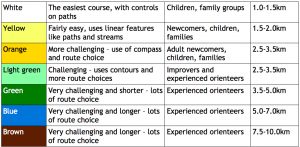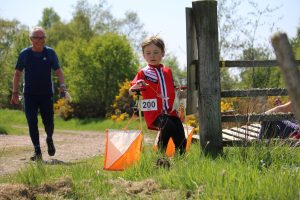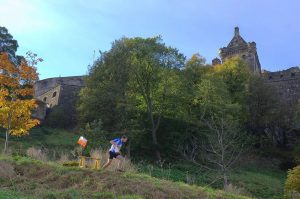What is orienteering?
Orienteering is an outdoor activity where you walk or run a course via a series of checkpoints, using a map for guidance. Most events take place in the Scottish countryside, so you can connect with nature and enjoy the breathtaking scenery of our forests and glens. If you prefer towns and cities, you can try urban orienteering, which provides different scenery and challenges.
If you like being active outdoors in Scotland and enjoy a challenging experience, orienteering is the perfect sport for you. You can enjoy it as an individual, a family, or any groups and all you need is a pair of trainers and comfortable clothing. Events take place throughout the year and many of these are totally accessible to people of differing levels of fitness and mobility.
What you do
 Using a detailed map, you navigate a course of “control” points, each of which is marked with an orange and white ‘kite’. There’s no set route between the controls, so you have to decide which way to go and find your way there.
Using a detailed map, you navigate a course of “control” points, each of which is marked with an orange and white ‘kite’. There’s no set route between the controls, so you have to decide which way to go and find your way there.
You’ll combine techniques including environmental awareness, decision making, planning and problem solving – so there’s much more to it than running – and fastest isn’t always best!
You can walk or jog around a course for the challenge, for the exercise or to enjoy the scenery, and you can enjoy it on your own or as a family-friendly activity. You can choose to view it as an adventure sport, a chance to connect with nature, an outdoor activity, a competitive sport, a social occasion or a solo activity.
What do all the different course names mean?
 Most orienteering events offer a range of courses with varying degrees of navigational difficulty, so there’s something to suit all ages and levels of fitness, experience and confidence. The easier courses stick to paths, while the harder ones require more complex navigation and advanced map reading skills. How the courses are graded may vary from event to event, so it’s best to ask one of the event volunteers, who’ll be happy to recommend a course for you to try.
Most orienteering events offer a range of courses with varying degrees of navigational difficulty, so there’s something to suit all ages and levels of fitness, experience and confidence. The easier courses stick to paths, while the harder ones require more complex navigation and advanced map reading skills. How the courses are graded may vary from event to event, so it’s best to ask one of the event volunteers, who’ll be happy to recommend a course for you to try.
Depending on the type of race, it may take 20 mins to 2 hours to complete. You can run or walk and be as competitive or uncompetitive as you like!
Another great thing about orienteering is that it’s not all about how fast you are, the mental and navigational aspects are just as important. Clubs often offer technique training so you can learn the basics and improve your navigation skills.
How to try orienteering in Scotland
 For individuals and families, the best way to try orienteering is to find and contact your local club, or check the fixture list for activities local to you. Your local club will let you know if they have any events specifically for beginners, or the next event to come along to. Clubs organise events or training at weekends and sometimes on weekday evenings. Somebody from the club will welcome you and give you some guidance before you’re set loose with a map. Some clubs also offer coaching sessions for newcomers.
For individuals and families, the best way to try orienteering is to find and contact your local club, or check the fixture list for activities local to you. Your local club will let you know if they have any events specifically for beginners, or the next event to come along to. Clubs organise events or training at weekends and sometimes on weekday evenings. Somebody from the club will welcome you and give you some guidance before you’re set loose with a map. Some clubs also offer coaching sessions for newcomers.
If you’re a student, some universities in Scotland have their own orienteering clubs, and you’re welcome to join your local club instead of a University Club if you’d prefer. Click here to find your local club.
There are also several Permanent Orienteering Courses around Scotland, where you can orienteer in your own time. Maps are free or very cheap; you can search for a course here.
If you are Edinburgh-based, why not head along to one of our newcomer-friendly events hosted by Orienteering Edinburgh every Thursday lunchtime? These are urban courses that require no previous orienteering experience or specialist equipment – just comfy clothing, a pair of trainers and a mobile phone! To find out more, visit the Orienteering Edinburgh website.
If you have any additional needs, please let the SOA or club know and we will do our very best to help – orienteering is really a sport for all!
Outdoor groups and schools
For outdoor groups, we recommend activity leaders join one of the practical training courses we offer in order for you to be comfortable and competent in leading your own activities, particularly the one-day Introducing Orienteering course. We can also arrange to lead a session with your group. Please contact us for further information.
For schools and classes, if you’re planning to orienteer on school grounds, we’ve produced guidance, activities and resources to help, which require minimal equipment and support pupil learning outcomes. If you’d like orienteering to become a common school activity, we’d recommend school staff attend an Introducing Orienteering course, to enable staff to lead activities with pupils.
What are courses and controls?

Each orienteering course has several controls you must visit in a specific order, and you choose your own route between them.
Each control is marked by a kite and has a unique code you check to make sure you’ve found the right one. The challenge is to decide your own route around the course, using the map you are given at the start. Will your controls be along paths, or hidden on earth banks, ditches or vegetation? Will your chosen route take you up steep hills or across boggy ground? You decide!
What happens at an event?
At competitive events, runners on the same course will start a minute or two apart to prevent everyone from following the person in front. Sometimes people catch each other up, but it’s never a good idea to blindly follow someone in case they make a mistake or they’re not looking for the same control as you.
Everyone carries an electronic chip which they use at each control to prove they’ve been there. When you finish, you receive a printout which shows you which controls you visited and how long it took you to get between the checkpoints.
Read more on what to expect at an event.
What equipment do I need to try orienteering?
All you need at your first event is to make sure you’re wearing comfortable clothing and footwear like trainers, which you can move easily in.
Beyond that a compass is very useful – particularly on the more difficult courses – and you can often borrow a compass from your club if you’re a complete beginner. Your event entry fee will include your own copy of the course map (it would be too easy if you could use GPS or phone maps!) and you can cheaply hire the electronic timing chips at each event.
It’s well worth contacting your local club in advance, so they can help welcome you on your first day.
Do I need to be a club member to try orienteering?
No – you’re more than welcome to try your first three events without being a member. After this, we ask you to become a member of your local club.
Are there any complex terms I should know?
No – you’ll soon pick things up! If you’d like to know what a particular term means, check out our A-Z Jargon buster.

